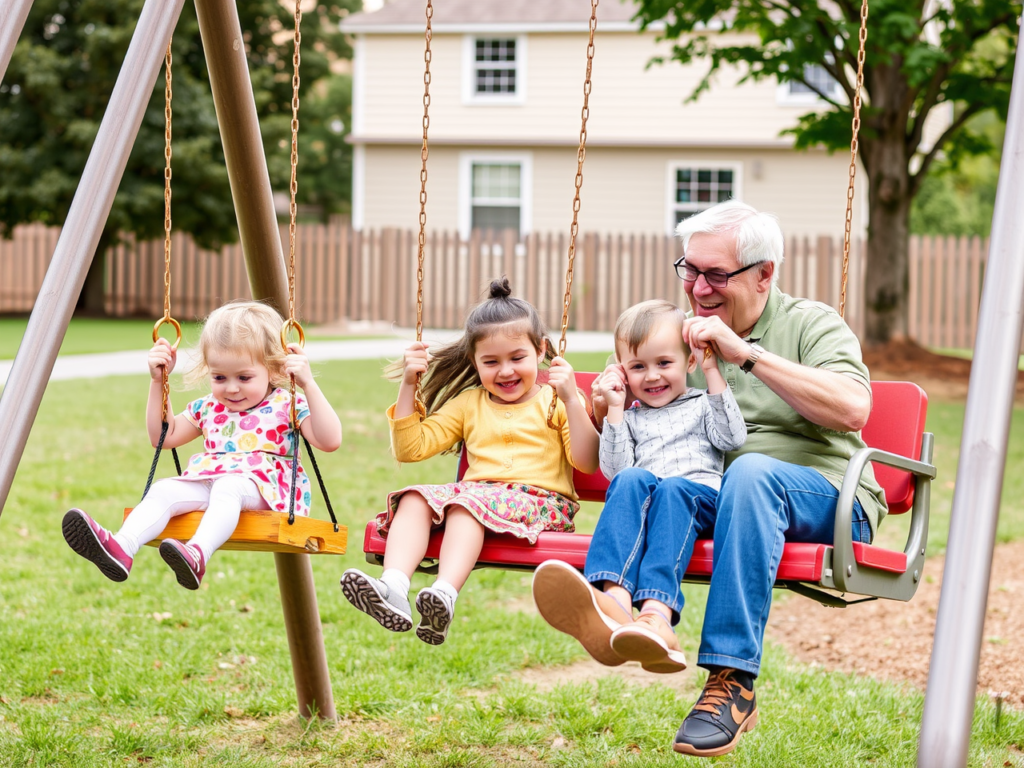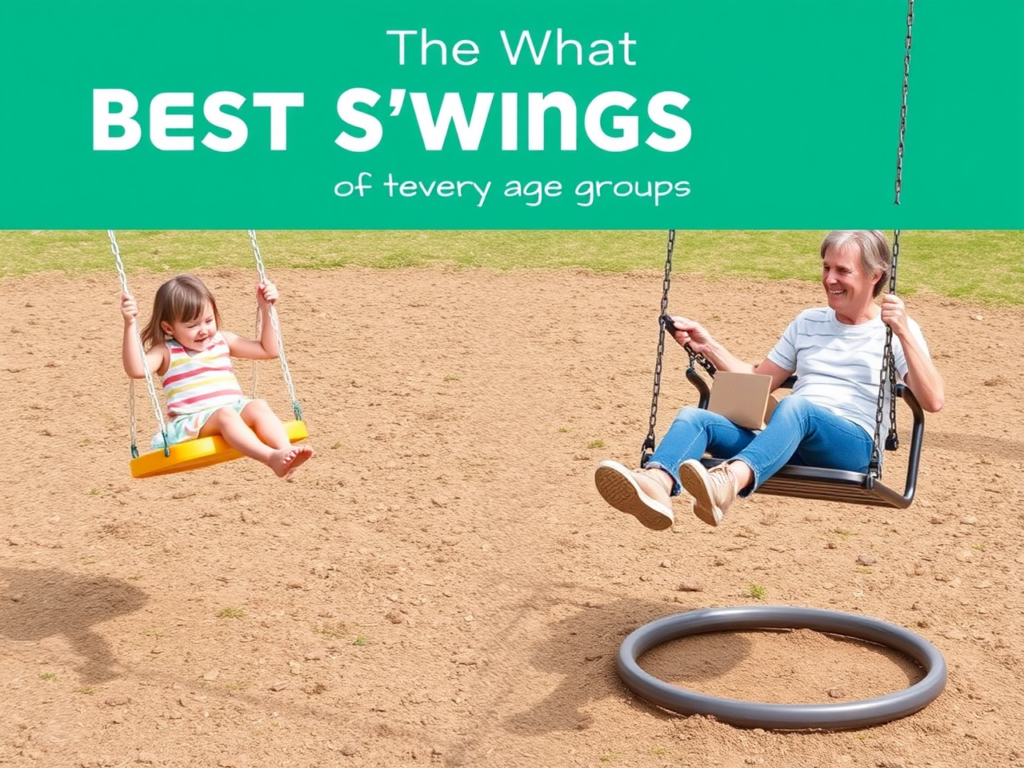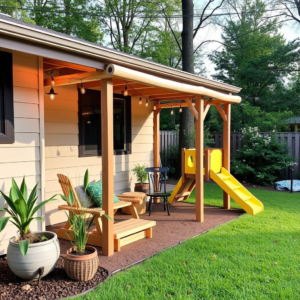Introduction to Swings and Their Importance

Swings have long been a staple in playgrounds and backyards, serving as more than just a source of joy and entertainment for children. The act of playing on the swing sets provides numerous developmental benefits that contribute significantly to a child’s overall growth. Engaging in swinging activities helps children physically develop their muscles and improve coordination and balance. The cyclical motion of swinging enhances core strength and promotes bodily awareness, making it an essential part of active play.
Additionally, playing on swing sets offers a unique opportunity for social interaction. Children often engage in cooperative play, taking turns and sharing swings with peers. Such interactions foster important social skills, including communication and collaboration, as children learn to navigate shared responsibilities and respect in play. This kind of socialization is vital for emotional well-being, enabling children to build friendships and develop a sense of community. Moreover, the simple act of swinging often brings about feelings of happiness and relaxation, proving beneficial for emotional health.
The importance of swinging extends beyond just physical and social aspects; it also contributes to cognitive development. As children navigate the experience of swinging, they engage in problem-solving when figuring out how to push themselves or how to swing higher. This cognitive engagement can enhance focus and critical thinking skills, critical components of childhood development.

In summary, the significance of playing on the swing sets is manifold, impacting physical, social, and emotional development. Understanding these benefits highlights the need for safe and accessible swinging opportunities for children of all age groups, paving the way for exploring various types of swings suited for different developmental needs.
Infants (0-12 Months): Safety First
For parents and caregivers, ensuring the safety of infants while playing on the swing sets is paramount. During the early months of life, infants require swings specifically designed for their age group, mainly baby swings and bouncers. These types of swings provide both comfort and security, allowing infants to enjoy the pleasant sensations of gentle rocking. The ideal baby swing often features a four-point harness system to keep the child securely in place, minimizing the risk of accidental falls.
When selecting a swing for infants, stability is a fundamental concern. A well-constructed bouncer or swing should have a wide base to prevent tipping, ensuring a safe environment for the baby. It is crucial to choose swings that adhere to current safety standards and are tested for durability. Parents should closely examine the materials used in the construction of the swing as well, opting for non-toxic and hypoallergenic fabrics to protect the sensitive skin of infants.
The gentle rocking motions of baby swings not only soothe infants but also promote sensory development. The rhythmic movement mimics the sensations experienced in the womb, providing a comforting experience that can aid in limb coordination and balance as babies begin to explore their capabilities. Furthermore, the soothing action can help alleviate fussiness, making it a practical choice for caregivers seeking to calm a restless infant.
Ultimately, choosing the right swing sets for infants involves a careful assessment of safety features, stability, and the benefits of gentle rocking motions. By prioritizing these aspects, parents can create a secure and enjoyable experience for their little ones, promoting both safety and sensory development while playing on the swing sets.
Toddlers (1-3 Years): Fun and Discovery
At the early stages of development, toddlers between the ages of one and three years experience an array of transformative growth. One of the most enriching activities during this phase is playing on the swing sets specifically designed for their age group. Bucket swings and simple rope swings serve as excellent recreational tools that not only provide enjoyment but also encourage exploration and physical activity.
Bucket swings are particularly advantageous for young children as they are designed with high backs and sides, ensuring safety while allowing toddlers to experience the joy of swinging. These swings enable toddlers to develop gross motor skills, including core strength and balance, as they learn to maintain stability while the swing is in motion. The rhythmic motion of swinging also contributes to their sensory development, offering a unique way to experience the world around them from a different perspective.
Moreover, incorporating additional playtime activities can significantly enhance the learning experience while using swing sets. For instance, parents and caregivers can engage toddlers in games that involve imaginative play, such as pretending to fly or exploring different animal movements while swinging. These activities not only make swinging more interactive, but they also help to reinforce vocabulary and communication skills. Simple songs or counting games can be introduced during swinging to make the experience both educational and entertaining.
In conclusion, the act of playing on the swing sets provides toddlers with a multifaceted platform for growth. Bucket and simple rope swings offer safe and enjoyable ways to develop essential skills while promoting a connection with their surroundings. Through incorporating creative play, swings can become integral tools in fostering healthy physical and cognitive development in young children.
Preschoolers (3-5 Years): Expanding Movement Skills
Preschoolers, typically aged between 3 to 5 years, undergo significant physical and social development, making this a crucial time for enhancing their movement skills. One exceptional way to facilitate this growth is by engaging them on various types of swings. Swings like platform swings and tire swings provide a unique opportunity for children to improve their balance and coordination while playing on the swing sets. These swings invite children to explore different movements, which are integral for their overall development.
Platform swings, which allow multiple children to sit or lie down together, foster important social interactions. When engaged in swinging activities, preschoolers can navigate their body movements while also learning to cooperate and share. Such dynamics enrich their social skills, as children communicate and collaborate on how to take turns or synchronize their swinging movements. Likewise, tire swings promote imaginative play as children can pretend that they are on a flying ship or visiting outer space, encouraging creativity and a sense of adventure.
Furthermore, the active play involved in swinging enhances a child’s physical capabilities. As they engage in playing on the swing sets, they naturally develop their core muscles, enhancing strength and stability. Swinging also requires the use of rhythm and momentum, which can help in refining their motor skills. As children push off the ground or pull themselves back up, they experience a sense of accomplishment, boosting their confidence in physical activities. Overall, these interactive and physically engaging experiences contribute to preschoolers’ movement skills and their emotional and social growth during this critical developmental stage.
Early Elementary (5-7 Years): Challenging Fun
During the early elementary years, children aged 5 to 7 years experience substantial physical and cognitive development. At this age, children begin to crave more challenging activities that can nurture their growing abilities and natural curiosity. This is where playing on the swing sets takes on a new meaning. Swings designed for this age group not only provide enjoyment but also serve as a tool for enhancing physical coordination and strength.
Complex swing sets, which might include features such as rope swings or tire swings, become increasingly appealing. These types of swings require a greater degree of balance and coordination, appealing to children’s developing skills. As they navigate these added challenges, children climb, swing, and coordinate their movements, fostering gross motor skills and building confidence in their physical capabilities. Additionally, the act of swinging itself can contribute to improved spatial awareness and body control.
Moreover, playgrounds that incorporate zip lines alongside traditional swing sets create exciting opportunities for collaborative play. Engaging with peers while playing on the swing sets or using zip lines promotes teamwork and communication among children. As they take turns or cheer for each other on challenging equipment, they learn valuable social skills essential for their ongoing development. These interactions also inspire creativity, as children often invent games or narratives surrounding their play activities, further enriching their imaginative experiences.
In summary, swing sets for early elementary aged children provide more than just entertainment; they present challenges that can enhance physical abilities, promote teamwork, and stimulate creativity. As children engage with more complex swing sets, they cultivate important skills that will benefit them as they transition into later childhood and beyond.
Middle Childhood (8-12 Years): Adventure and Independence
As children progress into middle childhood, typically ranging from ages 8 to 12, their play preferences evolve significantly, leaning towards activities that offer a sense of adventure and independence. At this age, many children are drawn to swings that provide exciting experiences and challenges, such as disc swings and adventure swings. These types of swings cater to their adventurous spirit, allowing them to explore their physical capabilities and gain confidence while playing.
Disc swings are particularly popular among this age group, as they are designed to accommodate multiple children and offer a unique, rotational experience. Unlike traditional swings which only swing back and forth, disc swings allow children to spin, engage in imaginative play, and experience a sense of freedom that invites them to challenge their balance and coordination. Similarly, adventure swings, which can include tire swings or those that mimic a flying experience, encourage older children to embrace daring play while sustaining their excitement for outdoor activities.
While the allure of adventure play is significant, the importance of safety cannot be understated. Ensuring that children are supervised while engaging in these more dynamic swinging activities is paramount. Adult supervision can help mitigate risks, allowing children to engage in their play with less worry and more enjoyment. Furthermore, securing the swings in an appropriate environment with adequate padding and a safe distance from any obstacles reinforces that the thrill of playing on the swing sets does not come at the expense of safety. By striking a balance between adventure and precaution, parents can foster a healthy play environment that encourages children to explore their independence while remaining secure.
Teenagers (13+ Years): Thrilling Experiences
As teenagers grow and start seeking more exhilarating activities, the world of swinging adapts to cater to their desire for excitement. Swing sets designed for older teens often feature oversized swings that accommodate multiple users, creating an inviting atmosphere for friends to enjoy together. These swings have become popular in community parks and playgrounds, where teenagers can engage in playful competitions, share laughter, and strengthen social bonds.
Beyond the conventional swing sets, thrill-seeking teenagers often turn to ride swings found in amusement parks. These can include giant swings that ascend high into the air and offer a breathtaking view, providing an adrenaline rush that younger swing sets cannot match. Such experiences allow teens to engage in swinging while embracing a more thrilling aspect, reinforcing the idea that swinging is not just for younger children.
Additionally, the emotional and social benefits of swinging remain relevant for teenagers. Engaging in swinging activities provides a unique opportunity for stress relief, helping the youth to escape the pressures associated with school and peer relationships. The physical aspect of swinging encourages movement and coordination, essential for promoting overall health during these formative years.
As teenagers bond over their swinging experiences, they may also develop a sense of community. The shared laughter and friendly competition can foster connections that last well beyond their adolescent years. Moreover, by incorporating other playground elements, such as climbing walls or slides, facilities catering to older children can create an engaging environment that offers varied experiences while still allowing them to enjoy the thrill of playing on the swing sets.
In conclusion, swinging offers thrilling experiences for teenagers, combining fun, excitement, and community building in an unparalleled manner. Appropriate swings not only cater to their adventurous spirit but also provide them with valuable physical and social benefits.

Inclusive Swings for Children with Special Needs
Inclusive swings play a vital role in recreational environments, specifically designed to cater to children with disabilities. They offer an essential means of participation in outdoor activities, promoting physical, social, and emotional development. These adaptive swings come in various designs, each tailored to address specific needs and mobility challenges, ensuring that all children can experience the joy of playing on the swing sets.
One popular type of inclusive swing is the belt swing that offers additional support harnesses or backrests to secure children comfortably while they play. This design allows those who may have difficulty maintaining balance to engage safely in swinging activities. Another option is the flat swing, which accommodates various sizes and provides ample space for children who may require assistance or adaptations for their comfort and safety. Moreover, specialized swings such as the bucket swing can be incredibly beneficial for younger children or those with limited mobility, as it offers sides that prevent accidental falls.
Safety features are paramount in the design of these inclusive swings. Many models incorporate shock-absorbing materials and safety harnesses to ensure that children remain secure while enjoying themselves. Additionally, the use of durable, weather-resistant materials guarantees long-lasting performance, providing a safe play environment regardless of external factors. Accessible ground surfaces and swing set installations are also crucial to eliminate barriers, so children can smoothly transition to and from the swings.
An inclusive play environment fosters social interaction among children with varying abilities, encouraging friendships and collaborative play. By prioritizing the availability of adaptive swings, communities send a strong message that every child deserves access to recreational activities. Providing opportunities for children with special needs to enjoy playing on the swing sets is vital to promoting inclusive and supportive communities.
Conclusion: The Joy of Swinging Across Ages
Swings have long been a staple in playgrounds, providing children with an opportunity for joy, exploration, and physical activity. The act of swinging, particularly for children, goes beyond mere play; it serves as a crucial aspect of development that can enhance motor skills, balance, and coordination. Each age group requires specific kinds of swings to ensure both safety and engagement. From infant swings designed for stability to more adventurous options for older children, the right choice can maximize the benefits of playing on the swing sets.
It is essential for parents and caregivers to recognize the importance of age-appropriate swings. Selecting the correct swing not only enhances the fun but also mitigates the risks associated with improper usage. For toddlers, bucket swings and T-bar swings offer the necessary support and security, while preschoolers might enjoy swings that promote independence, such as strap swings. As children grow, the transition to traditional swings allows for a sense of freedom, promoting larger movements that foster strength and confidence. Understanding the nuances of each developmental stage is key to optimizing the experience of swinging.
Moreover, the benefits of swinging extend beyond physical development; they also contribute to emotional well-being and social interaction. Whether it’s the thrill of swinging high or the simple joy of sharing the swing set with friends, the act of playing on the swing sets encourages connections and fosters resilience. In essence, swinging is not merely about the physical activity; it’s an integral part of childhood that nurtures a child’s growth in multiple dimensions. By embracing the joy of swinging at every age, we can ensure that children enjoy rich, fulfilling play experiences that are vital for their overall development.








